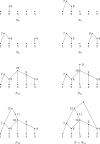Labellable Phylogenetic Networks
- PMID: 37097343
- PMCID: PMC10129972
- DOI: 10.1007/s11538-023-01157-0
Labellable Phylogenetic Networks
Abstract
Phylogenetic networks are mathematical representations of evolutionary history that are able to capture both tree-like evolutionary processes (speciations) and non-tree-like 'reticulate' processes such as hybridization or horizontal gene transfer. The additional complexity that comes with this capacity, however, makes networks harder to infer from data, and more complicated to work with as mathematical objects. In this paper, we define a new, large class of phylogenetic networks, that we call labellable, and show that they are in bijection with the set of 'expanding covers' of finite sets. This correspondence is a generalisation of the encoding of phylogenetic forests by partitions of finite sets. Labellable networks can be characterised by a simple combinatorial condition, and we describe the relationship between this large class and other commonly studied classes. Furthermore, we show that all phylogenetic networks have a quotient network that is labellable.
Keywords: Encoding; Orchard; Phylogenetic network; Tree-based.
© 2023. The Author(s).
Figures









References
Publication types
MeSH terms
LinkOut - more resources
Full Text Sources
Miscellaneous

